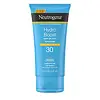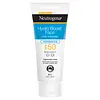Neutrogena Hydro Boost Water Gel Lotion Sunscreen SPF 30 Versus Neutrogena Hydro Boost Face Lotion Sunscreen SPF 50
What's inside
What's inside
 Key Ingredients
Key Ingredients

 Benefits
Benefits

No benefits
 Concerns
Concerns

 Ingredients Side-by-side
Ingredients Side-by-side

Homosalate 15%
Skin ConditioningOctocrylene 10%
UV AbsorberEthylhexyl Salicylate 5%
UV AbsorberButyl Methoxydibenzoylmethane 3%
UV AbsorberAcrylates/Dimethicone Copolymer
Skin ConditioningAlcohol Denat.
AntimicrobialAluminum Starch Octenylsuccinate
AbsorbentBlue 1 Lake
Cosmetic ColorantButyloctyl Salicylate
Skin ConditioningCaprylyl Methicone
Skin ConditioningChlorphenesin
AntimicrobialDimethicone
EmollientDisodium EDTA
Glycerin
HumectantGlyceryl Stearate
EmollientHydrolyzed Hyaluronic Acid
HumectantMenthyl Lactate
MaskingParfum
MaskingPentylene Glycol
Skin ConditioningPhenoxyethanol
PreservativePolyurethane-62
Silica
AbrasiveSodium Acryloyldimethyltaurate/Vp Crosspolymer
Emulsion StabilisingSodium Hydroxide
BufferingStyrene/Acrylates Copolymer
Tocopheryl Acetate
AntioxidantTrideceth-6
EmulsifyingWater
Skin ConditioningHomosalate 15%, Octocrylene 10%, Ethylhexyl Salicylate 5%, Butyl Methoxydibenzoylmethane 3%, Acrylates/Dimethicone Copolymer, Alcohol Denat., Aluminum Starch Octenylsuccinate, Blue 1 Lake, Butyloctyl Salicylate, Caprylyl Methicone, Chlorphenesin, Dimethicone, Disodium EDTA, Glycerin, Glyceryl Stearate, Hydrolyzed Hyaluronic Acid, Menthyl Lactate, Parfum, Pentylene Glycol, Phenoxyethanol, Polyurethane-62, Silica, Sodium Acryloyldimethyltaurate/Vp Crosspolymer, Sodium Hydroxide, Styrene/Acrylates Copolymer, Tocopheryl Acetate, Trideceth-6, Water
 Reviews
Reviews

Ingredients Explained
These ingredients are found in both products.
Ingredients higher up in an ingredient list are typically present in a larger amount.
Also known as Avobenzone, this ingredient is a chemical sunscreen filter that provides protection in the UV-A range.
Avobenzone is globally approved and is the most commonly used UV-A filter in the world.
Studies have found that avobenzone becomes ineffective when exposed to UV light (it is not photostable; meaning that it breaks down in sunlight). Because of this, formulations that include avobenzone will usually contain stabilizers such as octocrylene.
However, some modern formulations (looking at you, EU!) are able to stabilize avobenzone by coating the molecules.
Avobenzone does not protect against the UV-B range, so it's important to check that the sunscreen you're using contains other UV filters that do!
The highest concentration of avobenzone permitted is 3% in the US, and 5% in the EU.
Learn more about Butyl MethoxydibenzoylmethaneHomosalate is a chemical sunscreen filter that provides protection in the UV-B range (280nm - 320 nm), with a peak protection at 306 nm. It is internationally approved for use in sunscreens.
Homosalate is not photo-stable, meaning it's strength as a UV filter degrades over time with exposure to the sun. Because of this, it's often used in combination with other chemical sunscreen filters as avobenzone (which protects from the UV-A range). Homosalate also helps act as a solvent for harder-to-dissolve UV filters.
(Part of the reason that sunscreens need to be frequently re-applied is due to the photo instability of many chemical sunscreen filters)
Currently, homosalate is approved in concentrations up to 10% in the EU and 15% in the US. The FDA is currently doing further research on the effects of homosalate, and it is possible that these approved concentrations will change in the future.
Learn more about HomosalateOctocrylene protects skin from sun damage. It absorbs UV-B with peak absorption of 304 nm. It is a common sunscreen ingredient and often paired with avobenzone, a UVA filter. This is because octocrylene stabilizes other sunscreen ingredients by protecting them from degradation when exposed to sunlight. Octocrylene is a photostable ingredient and loses about 10% of SPF in 95 minutes.
Octocrylene also acts as an emollient, meaning it helps skin retain moisture and softens skin. It is oil-soluble and hydrophobic, enhancing water-resistant properties in a product.
Those who are using ketoprofen, a topical anti-inflammatory drug, may experience an allergic reaction when using octocrylene. It is best to speak with a healthcare professional about using sunscreens with octocrylene.
The EU allows a maximum of these concentrations:
Learn more about OctocrylenePhenoxyethanol is a preservative that has germicide, antimicrobial, and aromatic properties. Studies show that phenoxyethanol can prevent microbial growth. By itself, it has a scent that is similar to that of a rose.
It's often used in formulations along with Caprylyl Glycol to preserve the shelf life of products.